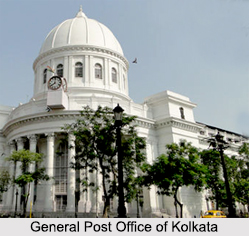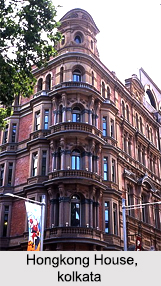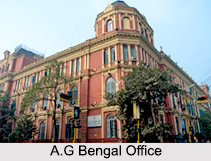 BBD Bagh, formerly known as the Dalhousie Square of colonial India is located in the Capital city of Kolkata in the state of West Bengal. Dalhousie Square gradually developed in to the administration headquarters of British East India Company after the city of Kolkata (Colonial Calcutta) was made the capital of British India until 1911. BBD Bagh, abbreviation of Benoy-Badal-Dinesh Bagh is replete with official buildings of the colonial era that proudly displays some magnificent architecture and has some intriguing history associated with it. Dalhousie square is also known as the "White Town" of Calcutta due to its British inhabitants and was named after colonial Administrator of British India, Lord Dalhousie.
BBD Bagh, formerly known as the Dalhousie Square of colonial India is located in the Capital city of Kolkata in the state of West Bengal. Dalhousie Square gradually developed in to the administration headquarters of British East India Company after the city of Kolkata (Colonial Calcutta) was made the capital of British India until 1911. BBD Bagh, abbreviation of Benoy-Badal-Dinesh Bagh is replete with official buildings of the colonial era that proudly displays some magnificent architecture and has some intriguing history associated with it. Dalhousie square is also known as the "White Town" of Calcutta due to its British inhabitants and was named after colonial Administrator of British India, Lord Dalhousie.
St. Andrew"s Church
St. Andrew"s Church, presently a place of worship for the Christians, was actually a seat of top religious minded Christians in the early British era. Some historical studies even stated that initially this church functioned as the High court of India in colonial Kolkata for a brief period of time.
General Post Office of Kolkata
General Post Office or G.P.O functions as the incumbent central post office for the city since its inception in 1864. History reveals that this G.P.O building has been built on the ruins of the first Fort William of colonial Calcutta. The former Fort William was badly demolished by the attacking troops of Siraj ud-Daulah, the then Nawab of Bengal. This incident also witnessed a historical massacre that is called Black Hole of Calcutta. Black Hole was a small dungeon inside Fort William where British soldier were imprisoned as prisoners of war. It led to the death of 143 British army men over night. As a memory to this incident, one of the survivors of the Black Hole Tragedy, military surgeon John Zephaniah Holwell erected a monument near Fort William known as the Black hole monument, which was later relocated to St. John"s church by Viceroy Lord Curzon during the rise of Nationalist and Extremist movements in India.
Lal Dighi
 Lal Dighi, as the name translated to "Red Pool" served at the main source of water supply for the British officers residing there. It is regarded as one of the heritage sites of BBD Bagh/ Dalhousie square. It was also known as "Tank Square" due to the presence of this lake. Where there is no proper historical evidence or proof behind the name "Lal Dighi" or "Red pool", it still serves as lake to the city of Kolkata.
Lal Dighi, as the name translated to "Red Pool" served at the main source of water supply for the British officers residing there. It is regarded as one of the heritage sites of BBD Bagh/ Dalhousie square. It was also known as "Tank Square" due to the presence of this lake. Where there is no proper historical evidence or proof behind the name "Lal Dighi" or "Red pool", it still serves as lake to the city of Kolkata.
Writer"s Building
Writer"s Building served as the building for writers of the British East India Company which later turned into the secretariat building of the Chief minister of West Bengal until 2013 when it was shifted to Nabanna. This giant structure that exhibits exquisite European architecture was constructed gradually part by part from 1776 to 1906.
Royal Insurance Building
Lying in a corner of Dalhousie square, present BBD Bagh, opposite G.P.O, Royal Insurance Building showcases an immense stature with much recognised European architecture. This building which presently houses government office was once the office of Royal insurance company. The company was popular in colonial India as it was one of its kinds to grant life insurance to British soldiers and officials.
Hongkong House
Hongkong House is another colonial building of the present BBD Bagh which is the head office of HSBC Bank in Kolkata currently. This place use to be a centre of trade and auction for the British East India Company. The auction here was mainly organised on the basis of "one inch candle rule" and even wealthy Indians and British officers took part in it. The HSBC Bank which is an abbreviation of Hongkong and Shanghai Banking Corporation was established as a result of this trade as most traders involved here were from Hong Kong, China.
Remington Typewriter Building
This building is now in a dilapidated condition and has been abundant since independence of India. The Remington Typewriter Building, located just beside Hongkong House use to be the office of the famous Type Writer Company "Remington Typewriter" in colonial India.
Council Office
The building, presently in an obsolete condition once used to be the office of the councillors of Calcutta, the Colonial Capital of India. Council Office has a unique plaque in Roman in front of the main entrance that stands as a memory for the date when King George V visited Calcutta in 1911.
High Court
Calcutta High Court presently acts as the apex judicial body of the State of West Bengal. History reveals that this was the first apex court in entire India under British rule. It also stated that the high court building was constructed for the very purpose and the entire judicial system was shifted from Town hall to this place to make it the apex and highest judicial body of British East India Company.
 A.G Bengal Office
A.G Bengal Office
Auditor General Office currently functions as Bengal Treasury office and is one of the heritages of BBD Bagh. However, according to history the building was constructed for the sole purpose of a five star hotel. In fact, it was the first luxury hotel in southern Asia known as "John Spence Hotel". Several eminent personalities during British rule in India have marked their visit in this hotel.
St. John"s Church
St. John"s Church was the first Anglican Cathedral of Calcutta till 1847 and is also the first public building by the British East India Company after Calcutta, present Kolkata, became the capital of British India. This Neoclassical architectural structure was built on an old graveyard that had an adjacent hospital for the British officials. Till date the Church compound houses graves of Job Charnock, Begum Johnson, Charlotte Canning and more, along with Second Rohilla War Memorial and the famous Black Hole of Calcutta Monument or Holwell Monument.
Metcalfe Hall
This heritage building built during 1840-1844 displays imperial Greek architecture and presently functions as a library which has a collection of rare journals and manuscripts along with exclusive books shifted from Fort William library. Metcalfe Hall was named after the then Governor of British India, Sir Charles T. Metcalfe.
Raj Bhawan
Designed by Capt. Charles Wyatt resembling a Neoclassical style of architecture with Baroque implication, Raj Bhawan presently functions as the residence of the Governor of West Bengal. This building was the government house of colonial India and was mainly known as the official residence of Lieutenant Governor of Bengal since the transfer of rule from British East India Company to British Crown.
Town Hall
Town Hall was built in 1813 for the sole purpose of offering the British official with a place to gather on social events and festivities. The monument presently serves the same purpose for the city of Kolkata.
Great Eastern Hotel
Built during the 1840s, this was a luxury hotel in British India, known as "Auckland Hotel" was named after George Eden, first Earl of Auckland, the then Governor General of India. During British rule the hotel was also popularly known as "Jewel of the East". Presently this Hotel has been taken over commercially and renamed as "The LaLiT Great Eastern Kolkata".
Apart from the above mentioned heritages in BBD Bagh/ Dalhousie Square there can be special mention of Fort William college, which was completely demolished by the troops of the Nawab of Bengal and was never reconstructed. Then there was Defence Ministry office of East India Company which is now in ruins but once was the centre for planning of World War 2 strategies.



















